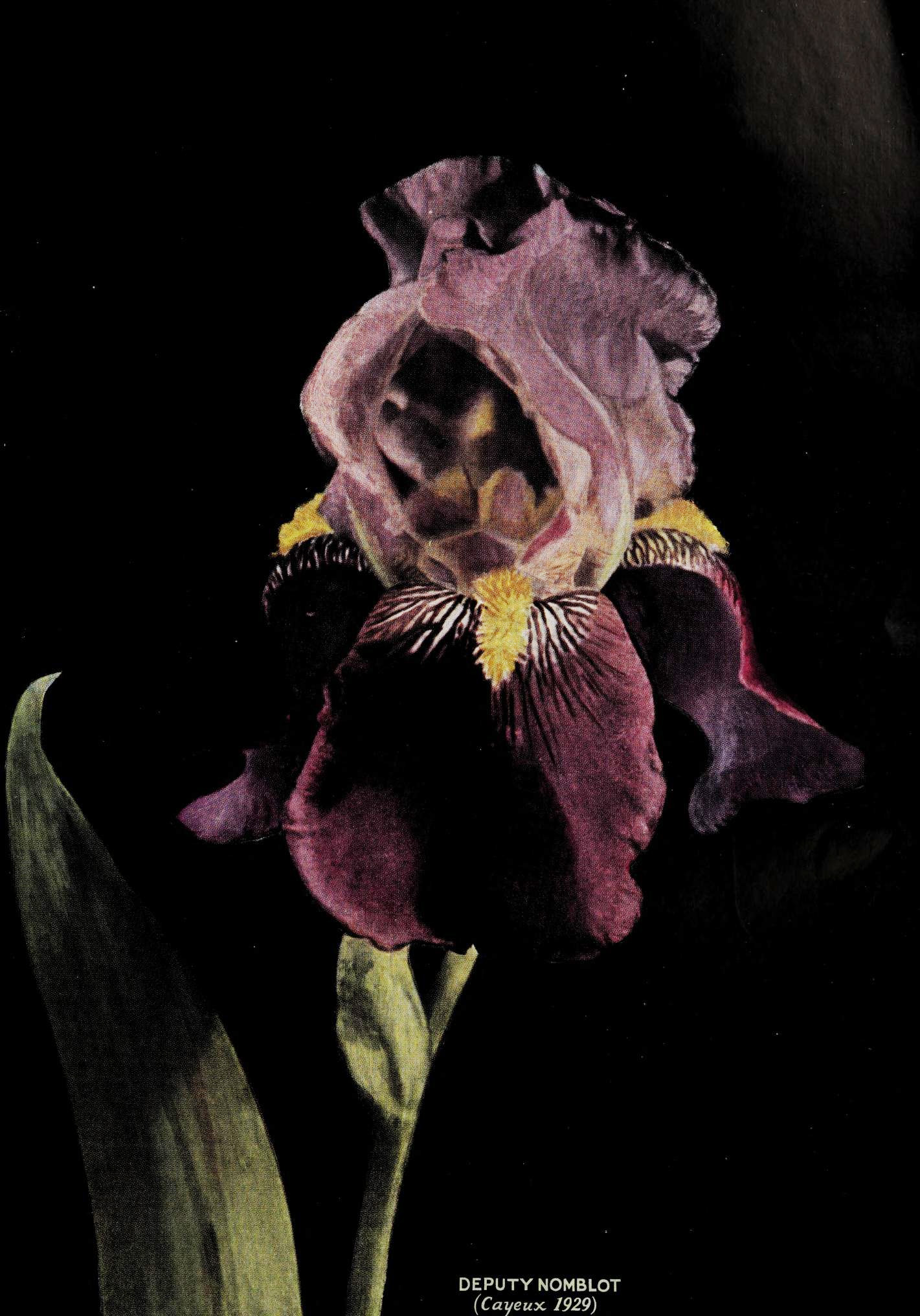| |
|
| Cayeux et Le Clerc catalog 1930, p. 5. | Bulletin de la Société Nationale d'Horticulture de France, 1930, 5e série, Tome III, p. 303.
Revue Horticole, 1937, Nouvelle série, Tome XXV, p. 527. | | | | DEPUTE NOMBLOT. The world's greatest iris. Blooming for the first time in America during the season of 1930, it almost bowled over all who saw it. During the past season it has proven worthy of first impressions, and from England and France, as well as from all sections of this country, come songs of praise for this imposing giant of the race. Standards light glowing rosy-purple, overlaid bronzy-gold. Falls very wide, spreading, purplish garnet-red, shading to lighter rosy-bronze at the edge. Deep orange beard. Over four feet tall, wonderfully well branched. DEPUTE NOMBLOT received a certificate of merit in 1929 at the Paris show, and in 1930 was awarded the Dykes medal. Each $20.00; three for $50.00. Cooley's Wholesale pricelist, 1932. | | From Elizabeth Hardee Iris Garden catalog, 1932: DEPUTE NOMBLOT (Day-pue-tay' Nome-Blow) (Cayeux 1929) M. 52" F. A really magnificent iris of great beauty of coloring, form and carriage. The flowers are large and well proportioned on very tall and widely branched stems. S. coppery red, flushed golden bronze. Falls wide and spreading, of a very rich shade of deep claret crimson. The entire flower seems lightly dusted with a fine golden powder which sparkles and glistens in the sunlight. English and French experts acclaim this as Cayeux’s finest achievement. (Awarded the Dykes Medal for 1930 by the N.H.F.). 20.00. | | Depute Nomblot: (Cayeux). A classic bloom—standard for form—rich—weak stalked; otherwise faultless. Belsley, Ray J., Varietal Comments. Bulletin of the American Iris Society 74 (July 1939), 16. | From Quality Gardens 1933 catalog: DEPUTE NOMBLOT (Day-pue-tay' N5me-Blow) {Cayeux 1929) M. 52" F. A really magnificent iris of such great beauty of coloring, form and carriage that we find it difficult to do it justice. The flowers are large and well proportioned on very tall and widely branched stems. S. copper red flushed golden bronze. Falls wide and spreading and of a rich shade of claret crimson. The entire flower seems lightly dusted with a fine golden powder which sparkles and glistens in the sunlight, giving the flower a hitherto unequalled richness of appearance. English and French and American experts acclaim this as Cayeux’s finest achievement. Dykes Medal, 1930, S.N.H.F. $9.00  |
|
|
| Cayeux et Le Clerc catalog 1930, p. 5. | Bulletin de la Société Nationale d'Horticulture de France, 1930, 5e série, Tome III, p. 303.
Revue Horticole, 1937, Nouvelle série, Tome XXV, p. 527. | | Depute Nomblot: (Cayeux). A classic bloom—standard for form—rich—weak stalked; otherwise faultless. Belsley, Ray J., Varietal Comments. Bulletin of the American Iris Society 74 (July 1939), 16. | | DEPUTE NOMBLOT. The world's greatest iris. Blooming for the first time in America during the season of 1930, it almost bowled over all who saw it. During the past season it has proven worthy of first impressions, and from England and France, as well as from all sections of this country, come songs of praise for this imposing giant of the race. Standards light glowing rosy-purple, overlaid bronzy-gold. Falls very wide, spreading, purplish garnet-red, shading to lighter rosy-bronze at the edge. Deep orange beard. Over four feet tall, wonderfully well branched. DEPUTE NOMBLOT received a certificate of merit in 1929 at the Paris show, and in 1930 was awarded the Dykes medal. Each $20.00; three for $50.00. Cooley's Wholesale pricelist, 1932. | | From Elizabeth Hardee Iris Garden catalog, 1932: DEPUTE NOMBLOT (Day-pue-tay' Nome-Blow) (Cayeux 1929) M. 52" F. A really magnificent iris of great beauty of coloring, form and carriage. The flowers are large and well proportioned on very tall and widely branched stems. S. coppery red, flushed golden bronze. Falls wide and spreading, of a very rich shade of deep claret crimson. The entire flower seems lightly dusted with a fine golden powder which sparkles and glistens in the sunlight. English and French experts acclaim this as Cayeux’s finest achievement. (Awarded the Dykes Medal for 1930 by the N.H.F.). 20.00. |
|
|

 Copyright © by the contributing authors. All material on this collaboration platform is the property of the contributing authors.
Copyright © by the contributing authors. All material on this collaboration platform is the property of the contributing authors. 